Friction and wear can lead to failure for water-lubricated mechanical elements; therefore, it is necessary to prepare material with antifriction and anti-wear performances to delay the failure for the elements in aqueous environments. Currently, the materials for the water-lubricated elements mainly include metal material[1], ceramic material[2], rubber material[3], engineering plastic[4] and graphite material[5]. In particular, the graphite material has a good self-lubricated performance, high temperature resistance, corrosion resistance and good mechanical processing performance. Due to these good properties, graphite materials have been widely applied to the water-lubricated sliding bearings[69].
Recently, many researchers have studied the friction and wear properties of carbon graphite materials[1012]. The tribological pairs include carbon graphite/silicon carbide friction[10], carbon graphite/316 stainless steel[11], and carbon graphite/stellite alloy[12]. For the carbon graphite and metal pair, the test results of friction and wear show that copious carbon debris is compacted on the counter-face, and the transferred film depends on pressure, sliding speed and the nature of the mating surface. The transferred film forms on the initial sliding stages due to the abrasive rapid wearing of graphite material, and the wear rate of carbon graphite is high at the initial sliding. Isostatic graphite is a newly-developed material, which is prepared by the cold isostatic pressing technique. The isostatic graphite is well known for its excellent properties, such as good self-lubrication, low particle size, low open porosity, homogeneous structure, isotropic properties, high hardness and strength. However, the isostatic graphite is a brittle material, and it may fail in a brittle or quasi-brittle fracture under mechanical loading. Sudden failure in the isostatic graphite is even more critical for components containing stress notches. Much research has studied the fracture properties of cracked components subjected to opening and sliding modes[1318]. However, to the best of our knowledge, there is no literature concerned with the tribological properties of the isostatic graphite material.
In this paper, the friction and wear properties of the isostatic graphite and the carbon graphite were studied under dry sliding and water lubricated conditions using a pin-on-disc tribometer. The friction coefficient and the wear rate were employed to characterize the friction and wear performance of the two graphite materials, and wear morphology was used to reveal the wear mechanism. This study aims to provide the basic data about the tribological properties of the two graphite materials under dry sliding and water-lubricated conditions.
1 Samples Preparation and Test Method
1.1 Samples preparation
Fig.1 shows a schematic diagram of the pin-on-disc friction pair. The material of the pin is stainless steel. The size of the pin is φ4.8 mm×12.7 mm, and the ball size is 4.75 mm. The surface roughness of the stainless steel pin is about 0.2 μm. Fig.2 shows the photo of the pin sample. The materials of the discs are the isostatic graphite and the carbon graphite, and the size of the disc is φ47 mm×5 mm.

Fig.1 The schematic diagram of pin-on-disc friction pair
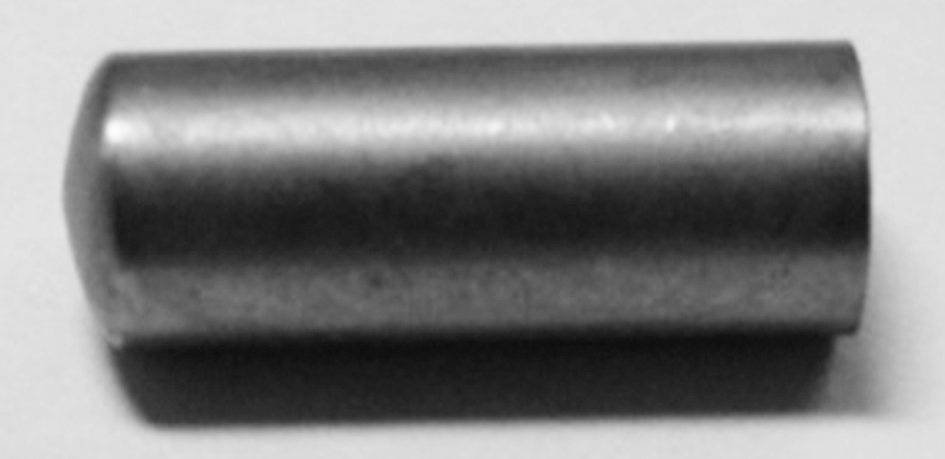
Fig.2 The pin sample
The isostatic graphite materials with 8% and 14% porosity were tested to show the effect of porosity on the friction and wear properties. Fig.3 shows the disc samples of the isostatic graphite and carbon graphite.
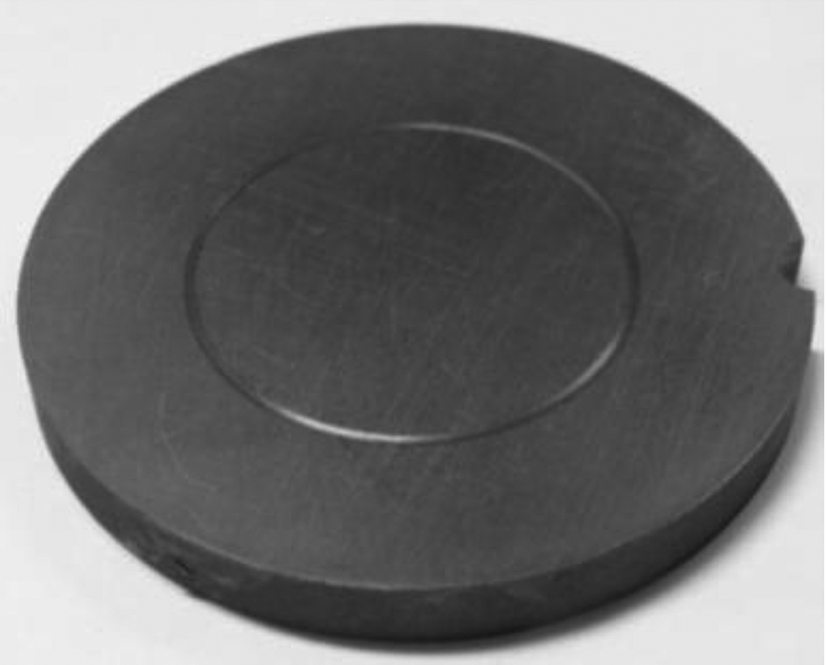
(a)
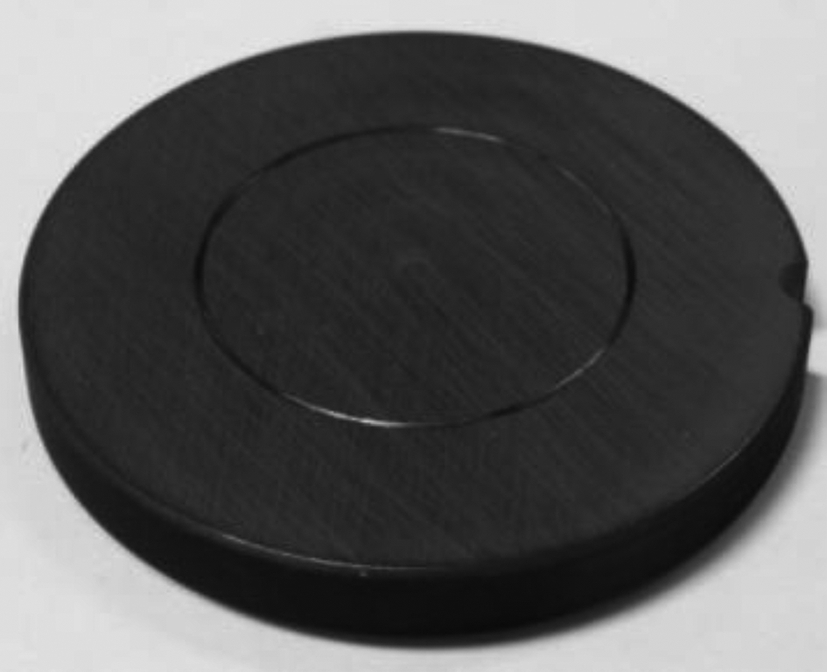
(b)
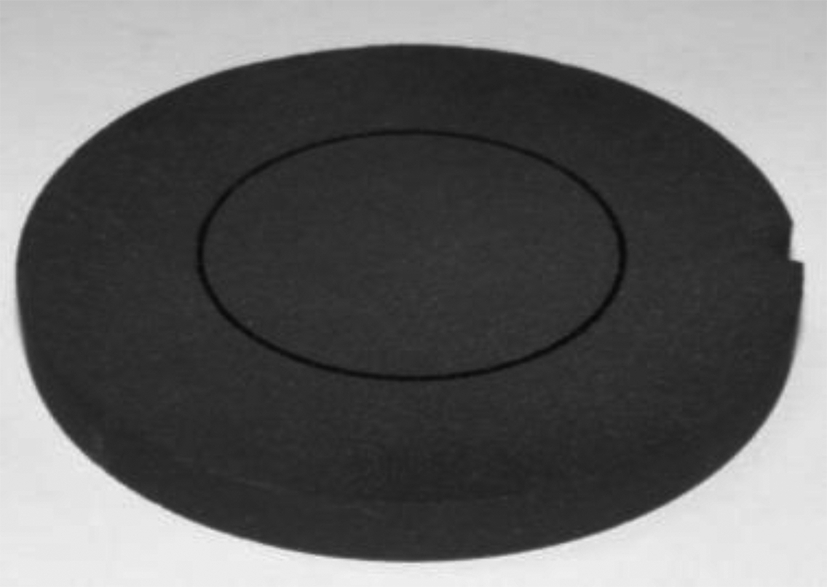
(c)
Fig.3 The disc samples. (a) Isostatic graphite with 14% porosity; (b) Isostatic graphite with 8% porosity; (c) Carbon graphite
The physical parameters of the isostatic graphite and carbon graphite are listed in Tab.1. With the decrease in the average particle size, the porosity of the isostatic graphite decreases and the volume density, shore hardness, compressive strength and flexural strength increase. The isostatic graphite reveals outstanding physical properties compared with the carbon graphite. Fig.4 shows the X-ray diffraction pattern of the isostatic graphite. The diffraction peaks of the isostatic graphite appear as hexagonal graphite (2H crystal structure) and rhombohedral graphite (3R crystal structure).
Tab.1 Physical parameters of the graphite materials
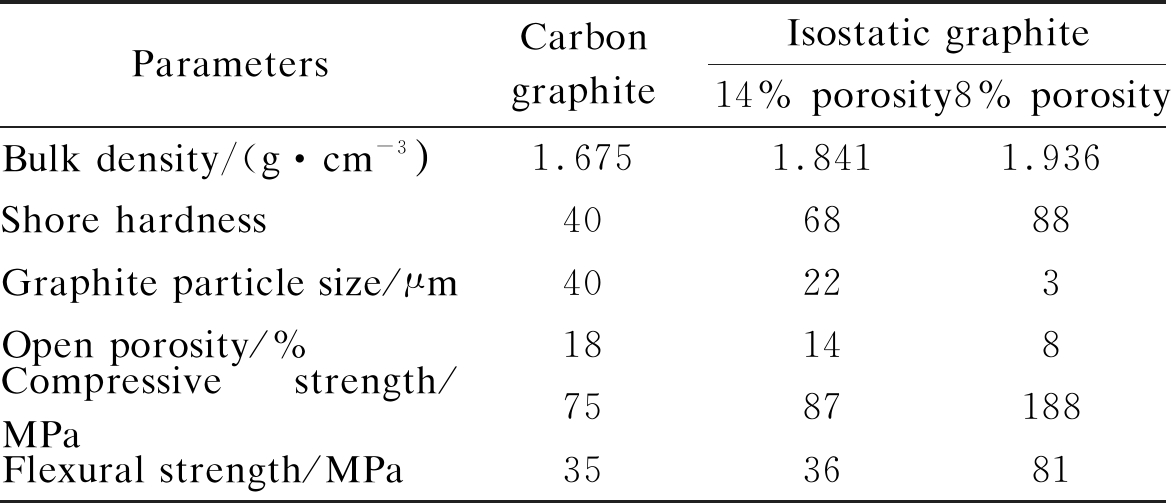
ParametersCarbongraphiteIsostatic graphite14% porosity8% porosityBulk density/(g·cm-3 1 6751 8411 936Shore hardness406888Graphite particle size μm40223Open porosity %18148Compressive strength MPa7587188Flexural strength MPa353681

Fig.4 X-ray diffraction pattern of the isostatic graphite
1.2 Friction and wear test
The pin-on-disc tribometer (MMW1A) was employed to study the friction and wear properties of the isostatic graphite, as shown in Fig.5. The samples were ultrasonically cleaned and dried before and after each test. The samples were weighed with a high-precision balance (accuracy: 0.01 mg). The wear rate of the samples were calculated according to the wear loss. The friction coefficient was obtained in real time by the tribometer. Each test was repeated three times. The roughness and wear morphology of the samples were observed by the confocal laser scanning microscope and optical microscope before and after the friction and wear tests. The experimental parameters for the tribological tests are with a normal load of 15 N and sliding speed of 0.068 m/s.
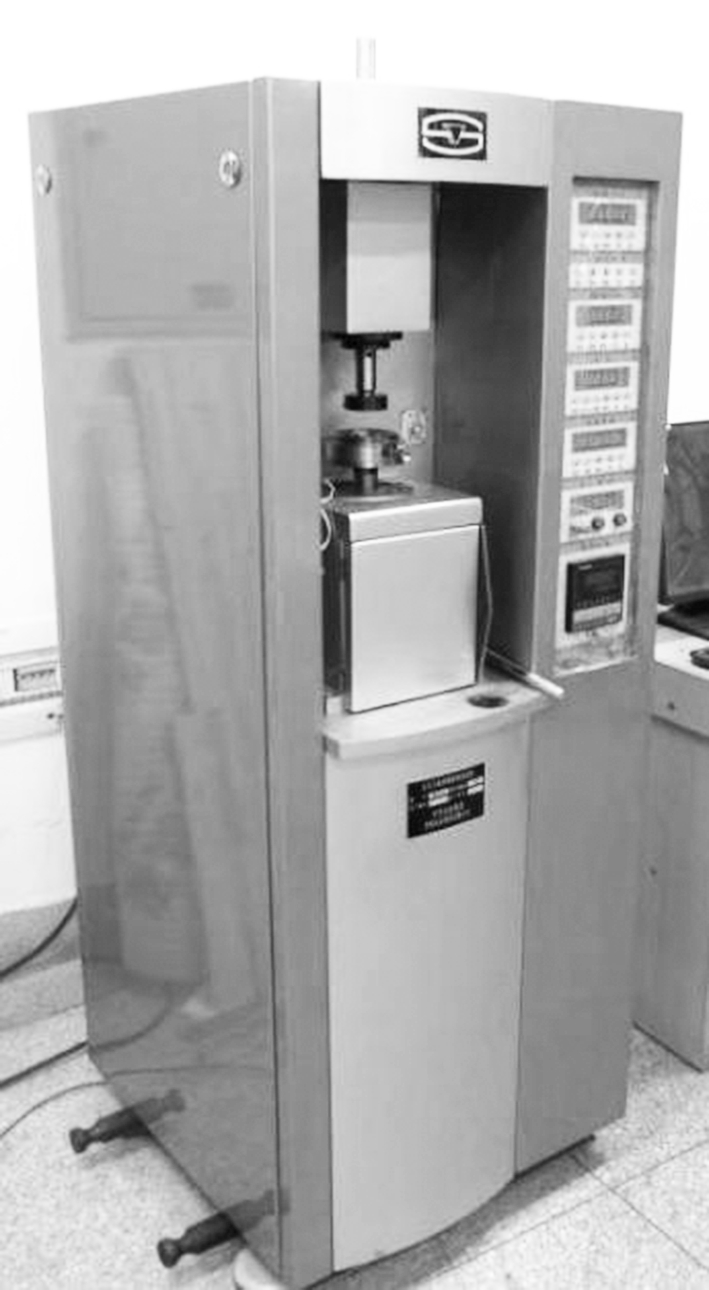
Fig.5 The pin-on-disc tribometer
2 Results and Discussion
2.1 Friction coefficient and wear rate
2.1.1 Dry sliding condition
Fig.6(a) shows the friction coefficient of the isostatic graphite (porosity: 8% and 14%) and carbon graphite under dry sliding condition as a function of test time. It can be seen that the dry friction coefficients of two types of the isostatic graphite are significantly larger than that of the carbon graphite. The friction coefficient of the isostatic graphite ranges from 0.18 to 0.22, and the friction coefficient of the carbon graphite is from 0.1 to 0.12. The friction coefficients of isostatic graphite and the carbon graphite decrease slightly as a function of test time.
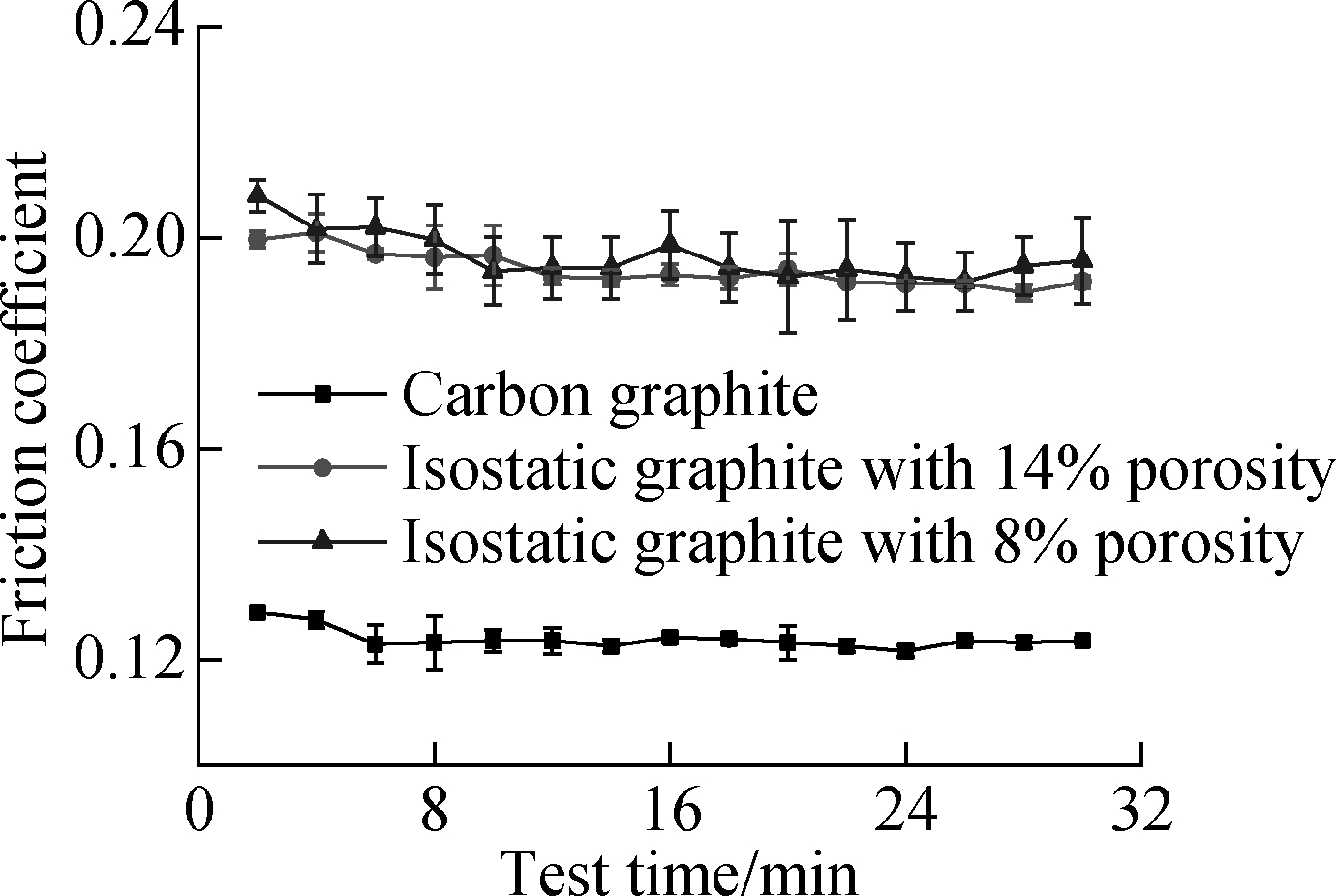
(a)
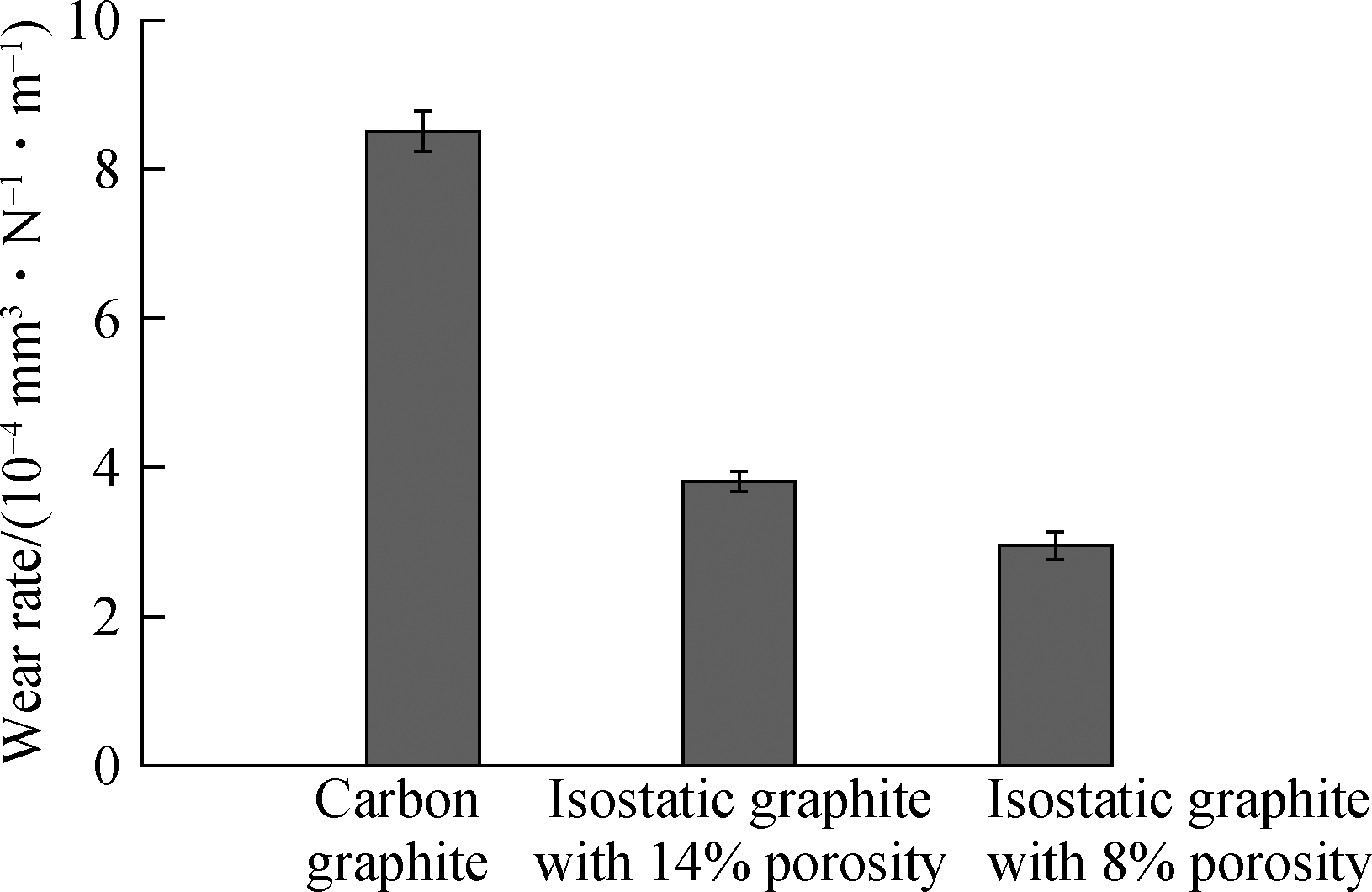
(b)
Fig.6 Friction coefficients and wear rate of graphite materials under dry sliding condition. (a) Friction coefficients; (b) Wear rate
Fig.6(b) shows the wear rates of the carbon graphite and the two types of the isostatic graphite under dry sliding conditions. It can be seen that the wear rates of the isostatic graphite are clearly lower than those of the carbon graphite, and the wear rates of the isostatic graphite increase with the increase in porosity. It is observed that the wear rates of the three graphite materials decrease with the increase in the sliding speed or the normal load. In particular, the carbon graphite appears a maximum reduction.
2.1.2 Water lubricated condition
Before the test, a series of previous trials were conducted to show that the friction pair can be in the boundary lubrication state when the normal load of 15 N and the sliding speed of 0.068 m/s are used. Fig.7(a) shows the friction coefficients of the carbon graphite, isostatic graphite with 8% and 14% porosity under the water lubricated condition. The friction coefficients of the carbon graphite and isostatic graphite under the water lubricated condition are lower than those under the dry sliding condition; especially, the friction coefficient of the isostatic graphite decreases significantly. The friction coefficient of the isostatic graphite with a porosity of 14% is even close to that of the carbon graphite. The friction coefficient of the isostatic graphite decreases with the decrease in the porosity. In contrast to the dry sliding condition,the friction coefficients of three graphite materials show little change as a function of test time.

(a)
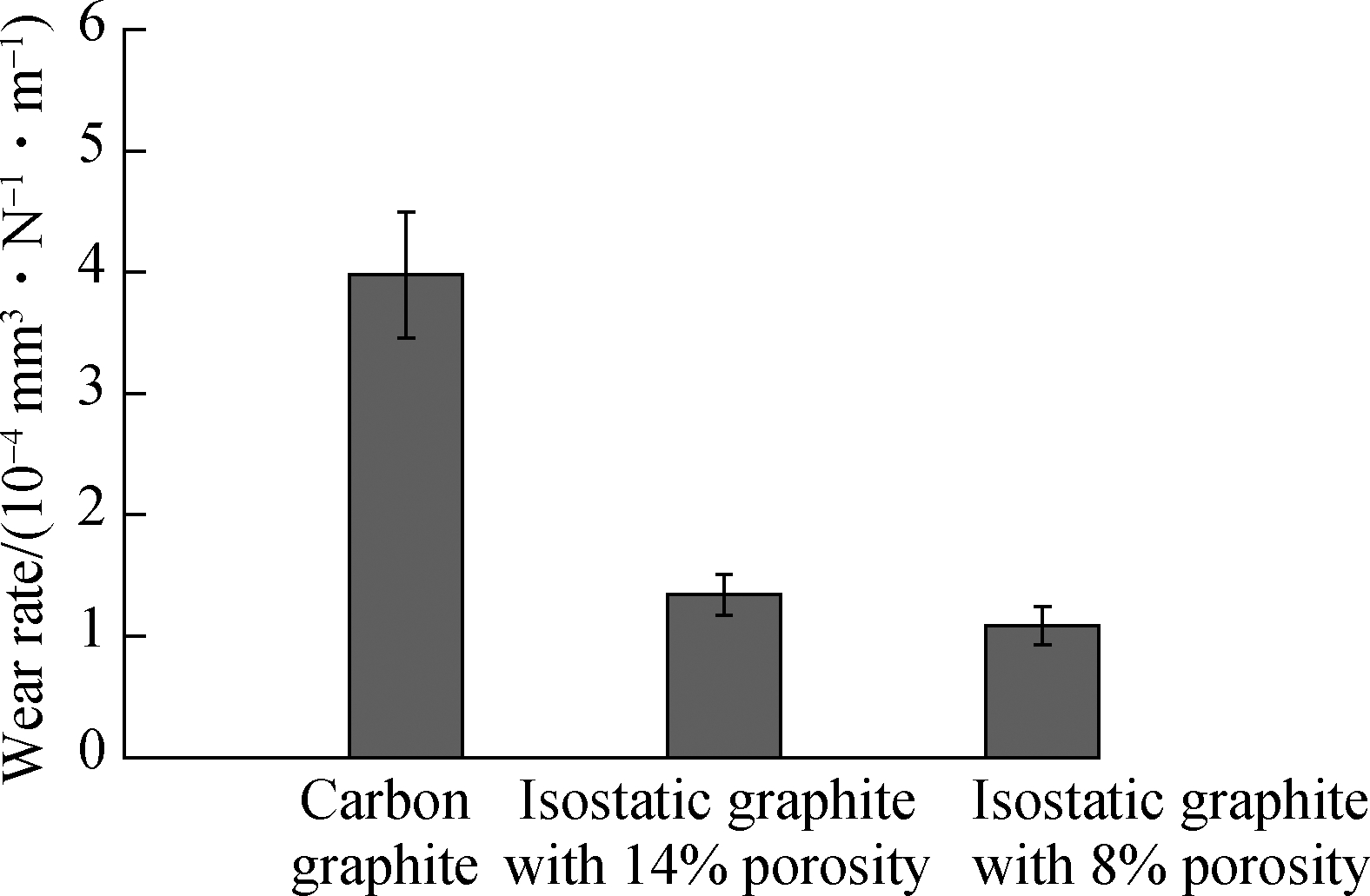
(b)
Fig.7 Friction coefficient and wear rate of graphite materials under water lubricated condition. (a) Friction coefficients; (b) Wear rate
Fig.7(b) shows the wear rates of the carbon graphite and the isostatic graphite under the water lubricated condition. It can be seen that the wear rate of the isostatic graphite is lower than that of the carbon graphite, and the wear rate of the isostatic graphite decreases with the decrease in the porosity. The wear rates of these three kinds of graphite materials under the water lubricated condition are lower than those under the dry sliding condition.
2.2 Tribological mechanism
2.2.1 Dry sliding condition
Fig.8 shows the wear morphologies of the carbon graphite and the isostatic graphite under the dry sliding condition. It can be seen that the wear form of the carbon graphite under the dry sliding condition is spalling wear with slight particle wear; while the wear form of the isostatic graphite is abrasive wear, and a plowing action appears on the worn surface.
The results in Section 2.1 show that the friction coefficients of the isostatic graphite materials are significantly larger than those of the carbon graphite under the dry sliding condition. Based on the wear morphologies, a possible explanation for this might be that the isostatic graphite has a compact accumulation of particles, small porosity and high hardness, while the carbon graphite exhibits loose accumulation of particles, large porosity and low hardness. Compared with the carbon graphite, the isostatic graphite has a higher shear-resistance property. As a result, the friction coefficient of the isostatic graphite is larger than that of the carbon graphite under the dry sliding condition.

(a)
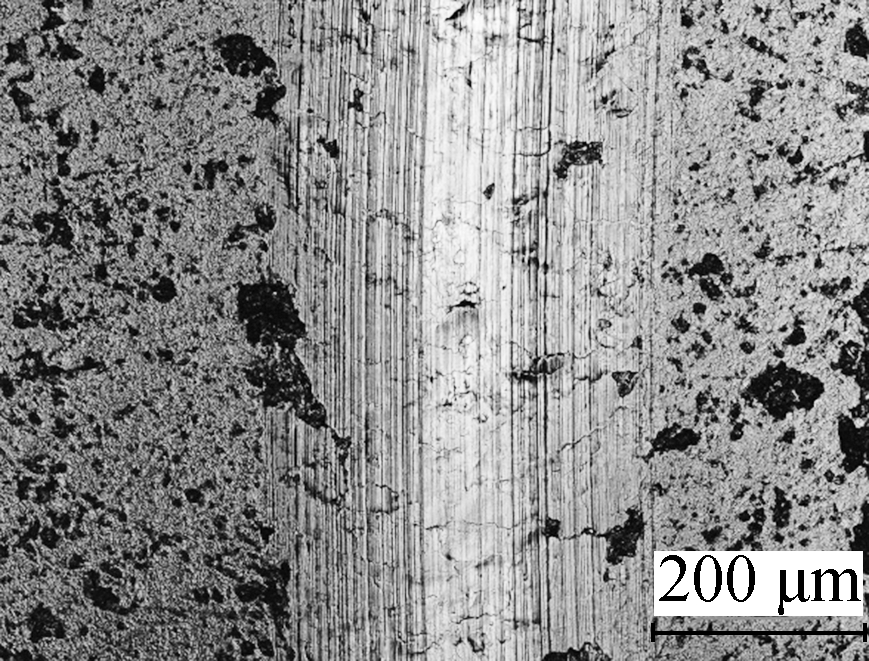
(b)
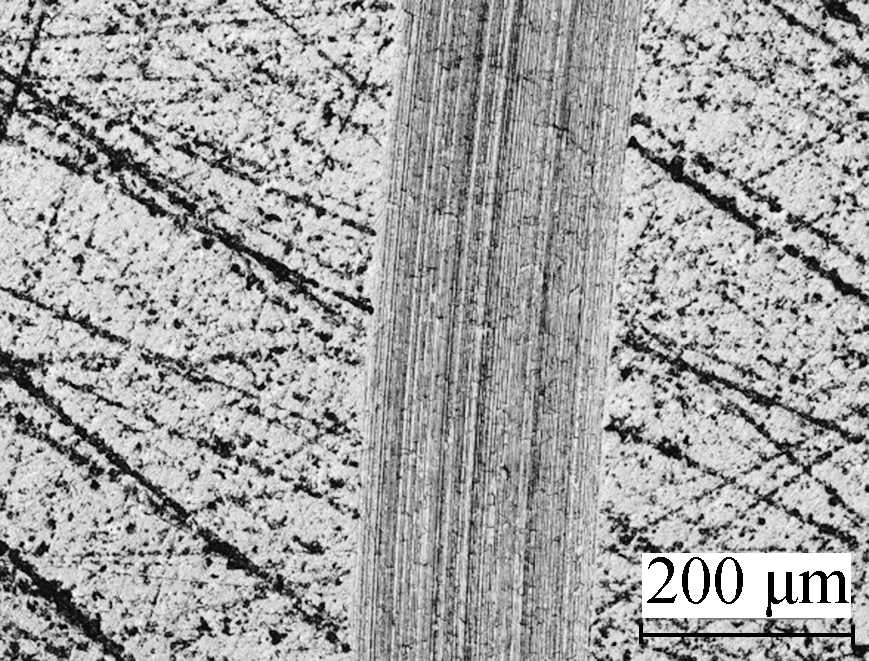
(c)
Fig.8 Wear morphologies of graphite materials under the dry sliding condition. (a) Carbon graphite;(b) Isostatic graphite with 14% porosity; (c) Isostatic graphite with 8% porosity
2.2.2 Water-lubricated condition
Fig.9 shows the wear morphologies of the carbon graphite and the isostatic graphite under the water lubricated condition. It can be seen that the main wear form of the carbon graphite is also spalling wear with slight particle wear, while the wear form of the isostatic graphite is mainly abrasive wear with a plowing action.
The results in Section 2.2 show that the friction coefficients and wear rates of the three graphite materials decrease under the water lubricated condition, and the decreased degree of the isostatic graphite is significantly larger than that of the carbon graphite. In this section, the surface roughness of the three graphite materials under dry sliding and water-lubricated conditions is tested to explain the friction and wear mechanism. The roughness values are listed in Tab.2. The results show that the surface roughness values of three graphite samples under the water lubricated condition are lower than those under the dry sliding condition.
There are two possible explanations for this result: 1) For the water-lubricated condition, the spalled graphite particles are mixed with the lubrication water. The mixture containing the graphite particles adsorbs on the contact zone of the friction pair, and the graphite particles tend to be deposited on the worn surface of graphite material, so that the worn pits can be filled up during the test. 2) It is inevitable that there is the squeeze lubrication effect for the friction pair due to the porous structure of the graphite material. In summary, it is understandable that the friction coefficient and the wear rate under the water-lubricated condition are lower than those under the dry sliding condition.

(a)
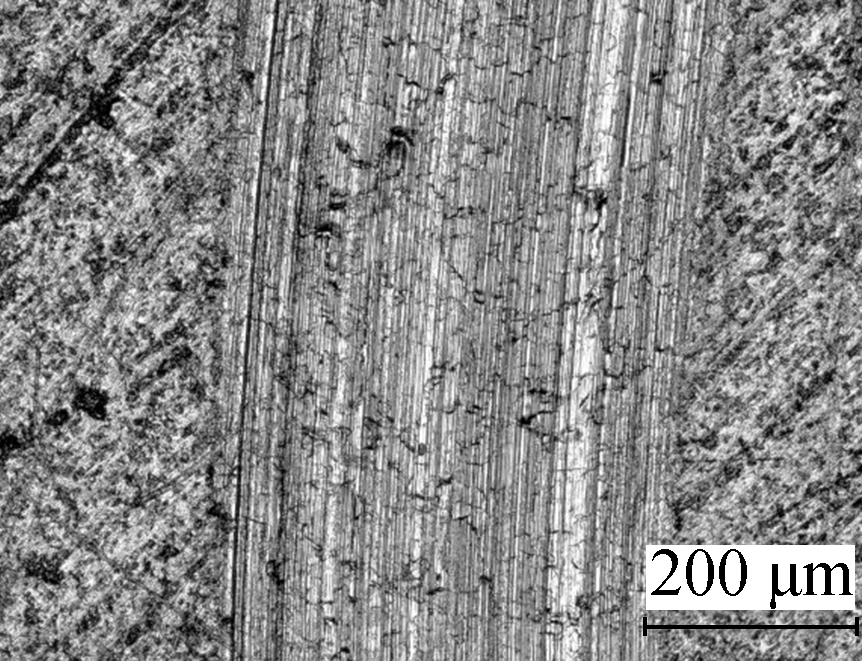
(b)
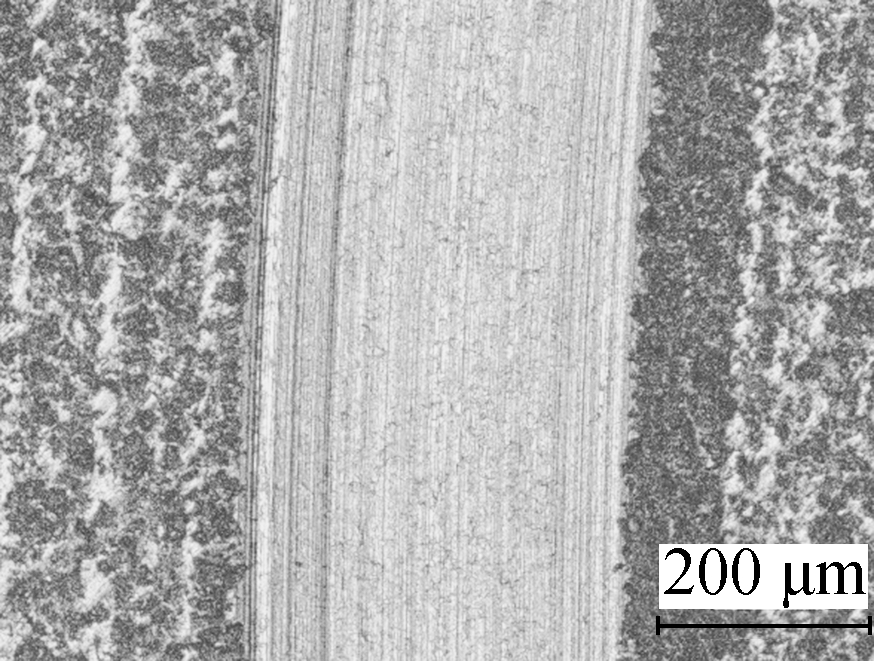
(c)
Fig.9 Wear morphologies of graphite materials under the water lubricated condition. (a) Carbon graphite; (b) Isostatic graphite with 14% porosity; (c) Isostatic graphite with 8% porosity
Tab.2 Roughness values of graphite materials after lubrication tests

MaterialsAlong the wear scar channel μmPerpendicular to the wear scar channel μmDry slidingWater lubricationDry slidingWater lubricationCarbon graphite2 081 712 822 43Isostatic graphite with 14% porosity1 911 672 672 31Isostatic graphite with 8% porosity1 801 492 512 18
3 Conclusions
1) Under the dry sliding condition, the friction coefficient of the isostatic graphite is significantly larger than that of the carbon graphite; however, the wear rate of the isostatic graphite is clearly lower than that of the carbon graphite.
2) Under the water-lubricated condition, the friction coefficient and wear rate of the two types of graphite are much less than those under the dry sliding condition, especially for the isostatic graphite.
3) For the dry sliding and water-lubricated conditions, the wear form of the carbon graphite is mainly spalling wear, and the wear form ofthe isostatic graphite is mainly abrasive wear.
[1] Zhang G Y, Yuan X Y, Dong G N. The tribological behavior of Ni-Cu-Ag-based PVD coatings for hybrid bearings under different lubrication conditions[J]. Tribology International, 2010, 43(1/2): 197201. DOI:10.1016/j.triboint.2009.05.032.
[2] Durazo-Cardenas I S, Corbett J, Stephenson D J. The performance of a porous ceramic hydrostatic journal bearing[J]. Proceedings of the Institution of Mechanical Engineers, Part J: Journal of Engineering Tribology, 2010, 224(1): 8189. DOI:10.1243/13506501jet570.
[3] Cabrera D L, Woolley N H, Allanson D R, et al. Film pressure distribution in water-lubricated rubber journal bearings[J]. Proceedings of the Institution of Mechanical Engineers, Part J: Journal of Engineering Tribology, 2005, 219(2): 125132. DOI:10.1243/135065005x9754.
[4] Kuang F M, Zhou X C, Huang J, et al. Tribological properties of nitrile rubber/UHMWPE/nano-MoS2 water-lubricated bearing material under low speed and heavy duty[J]. Journal of Tribology, 2018, 140(6): 061301. DOI:10.1115/1.4039930.
[5] Zhang R J, Wu Z D, Zhang H. Test investigation on water-lubricated journal bearing with silicified graphite layer for the pump-motor in nuclear plant [J]. Energy Conservation Technology, 2003, 21: 2223. DOI: 10.3969/j.issn.10026339.2003.03.010. (in Chinese)
[6] Zhang F, Li Y Z, Jia Q, et al. Preparation and properties of graphite bearings lubricated with water for nuclear main pump [C]//The Eleventh National Tribology Congress in China. Lan Zhou, China, 2014:15. (in Chinese)
[7] LiM Q, Wang W G, Li C X, et al. Study on wear debris in water lubricated thrust bearing of nuclear main pump after rig test[J]. Lubrication Engineering, 2016, 41(9): 113120. DOI: 10.3969/j.issn.0254-0150.2016.09.021. (in Chinese)
[8] Wang X R, Zhang X, Yang L H, et al. Research on friction and wear properties of water-lubricated graphite thrust bearings and their mechanisms [J]. Journal of Jiamusi University (Natural Science Edition), 2017, 35: 788791. DOI: 10.3969/j.issn.10081402.2017.05.022. (in Chinese)
[9] Wang X R, Wang P, Wang D, et al. Design of main pump motor’s water lubricated bearing and research on its lubricating performances [J]. Journal of Jiamusi University(Natural Science Edition), 2012, 30: 559562. DOI: 10.3969/j.issn.1008-1402.2012.04.021. (in Chinese)
[10] Jones G A. On the tribological behaviour of mechanical seal face materials in dry line contact: Part I. Mechanical carbon[J]. Wear, 2004, 256(3/4): 415432. DOI:10.1016/S0043-1648(03)00539-8.
[11] Williams J A, Morris J H, Ball A. The effect of transfer layers on the surface contact and wear of carbon-graphite materials[J]. Tribology International, 1997, 30(9): 663676. DOI:10.1016/S0301-679X(97)00034-0.
[12] Batchelor A W, Lam L N, Chandrasekaran M. Lubrication of stellite at ambient and elevated temperatures by transfer films from a graphite slider[J]. Wear, 1996, 198(1/2): 208215. DOI:10.1016/0043-1648(96)06967-0.
[13] Salavati H, Alizadeh Y,Ayatollahi M R. Fracture assessment of inclined double keyhole notches in isostatic graphite[J]. Physical Mesomechanics, 2018, 21(2): 110116. DOI:10.1134/S1029959918020030.
[14] Torabi A R. Sudden fracture from U-notches in fine-grained isostatic graphite under mixed mode Ⅰ/Ⅱ loading[J]. International Journal of Fracture, 2013, 181(2): 309316. DOI:10.1007/s10704-013-9832-5.
[15] Berto F, Lazzarin P, Ayatollahi M R. Brittle fracture of sharp and blunt V-notches in isostatic graphite under torsion loading[J]. Carbon, 2012, 50(5): 19421952. DOI:10.1016/j.carbon.2011.12.045.
[16] Berto F, Lazzarin P, Ayatollahi M R. Brittle fracture of sharp and blunt V-notches in isostatic graphite under pure compression loading[J]. Carbon, 2013, 63: 101116. DOI:10.1016/j.carbon.2013.06.045.
[17] Lazzarin P, Berto F, Ayatollahi M R. Brittle failure of inclined key-hole notches in isostatic graphite under in-plane mixed mode loading[J]. Fatigue & Fracture of Engineering Materials & Structures, 2013, 36(9): 942955. DOI:10.1111/ffe.12057.
[18] Berto F, Lazzarin P, Marangon C. Brittle fracture of U-notched graphite plates under mixed mode loading[J]. Materials & Design, 2012, 41: 421432. DOI:10.1016/j.matdes.2012.05.022.